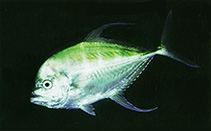| Family: |
Carangidae (Jacks and pompanos), subfamily: Caranginae |
| Max. size: |
58 cm TL (male/unsexed); max.weight: 3,500.0 g |
| Environment: |
reef-associated; brackish; marine; depth range 1 - 59 m |
| Distribution: |
Indo-West Pacific: Red Sea, Gulf of Oman and along the African coast (to East London in South Africa, Ref. 3197) and the west coast of Madagascar to southern India and Sri Lanka. There are reliable reports from the Gulf of Thailand, Hong Kong, Okinawa and Japan. |
| Diagnosis: |
Dorsal spines (total): 9-9; Dorsal soft rays (total): 19-22; Anal spines: 3-3; Anal soft rays: 16-18. Description: Bluish grey dorsally, shading to silvery on side, with blackish blotch on upper rear margin of the opercle (Ref. 90102). Body strongly compressed and deep; head profile very deep in adult (Ref. 48635, Ref. 90102). Snout sub equal to eye in length (Ref. 559). Breast scaleless ventrally to behind origin of pelvic fins. LL scutes 11-24, weak; total elements 25-43. Anterior lobes of first dorsal and anal fins elongate with growth. Dorsal fin of males (larger than about 21 cm FL) with 3 central rays produced into filaments of variable length (Ref. 90102). |
| Biology: |
Adults are found in coastal waters near corals and rocks, also in shallow lagoons (Ref. 30573). Solitary species on inshore reefs (Ref. 48635). Small groups frequently patrol perimeter of reefs (Ref. 90102). Juveniles may enter estuaries (Ref. 5213). Behaviour of shadowing a larger fish was observed, expected to be more common for juvenies (B. Hazes, pers. comm. 3/2023). |
| IUCN Red List Status: |
Least Concern (LC); Date assessed: 17 July 2017 Ref. (130435)
|
| Threat to humans: |
harmless |
Source and more info: www.fishbase.org. For personal, classroom, and other internal use only. Not for publication.
